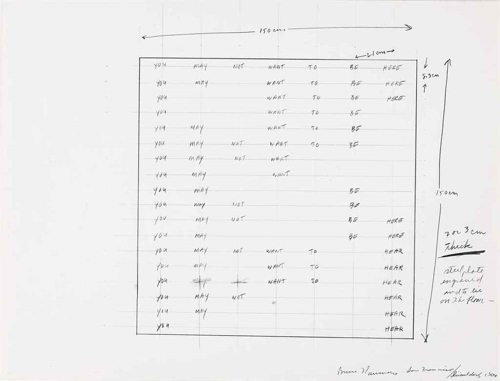listening, auditoria, audiences / écoute, auditeurs, auditoriums : — Studies —
AUDITORIAétude / studySIX SOUND PROBLEMS (BRUCE NAUMAN)
|
|
Cette série explore les œuvres prenant la notion d'auditorium comme principe / This series is a study about works based on principles of auditoria. • COMPOSING THE NOW (Michel Waisvisz) - 2003 — read /lire • JULES VERNE - (Auditoires, Noise et Aventures Acoustiques / ''Audiences, Noise and Acoustic Adventures'') - XIX° — read /lire • BREATH (Gerald Shapiro) - 1971— read /lire • THE HANDPHONE TABLE (Laurie Anderson) - 1978— read /lire • LAURIE ANDERSON (Early Works 1971-1978)— read /lire • SIX SOUND PROBLEMS (Bruce Nauman) - 1968— read /lire |
 (Bruce Nauman, Times Magazine, nov. 1968) |
(This study is mainly in English)
— — (Cette étude est en anglais)
Presentation(Edit)
SIX SOUND PROBLEMS
sous-titre / subtitle : (6 Day Week – Six Sound Problems for Konrad Fischer)
Bruce Nauman
1968.
| Durée approximative | — (continue / infinite) | |
| Dates de composition | — 1968 | |
| Création | — Düsseldorf, Galerie Konrad Fischer, July 10–August 8, 1968 | |
| Dispositif : | — Tape deck with six soundtracks of varying duration, chair with pencil, dimensions variable Magnétophone à bande avec six boucles de différentes durées, chaise et crayon, dimensions variables | |
| Éditeur : | — |
| Taped sounds : • Monday – Walking in the gallery. • Tuesday – Bouncing two balls in the gallery. • Wednesday – Violin sounds in the gallery. • Thursday – Walking and bouncing balls. • Friday – Walking and violin sound. • Saturday – Violin sounds and bouncing balls. | 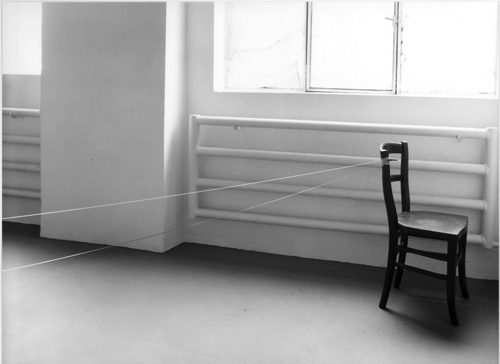 tape deck with six soundtracks of varying duration, chair with pencil, dimensions variable. |
| In Six Sound Problems for Konrad Fischer, a piece done in the summer of 1968 at the Galerie Konrad Fischer in Düsseldorf, Nauman set up discrepancies between what one knows and what one sees. This piece mixed recorded sounds with the natural noises of the environment. On the plan for this work (drawn first backwards and then correctly), Nauman notes, « 6 sound problems for Konrad Fischer — (6 day week) / 1. walk / 2. balls / 3. violin 4. violin w. walk / 5. violin w/ balls / 6. balls w/ walk / must be short can be very short / loop 1 / monday / 2 tuesday / wednesday 3/ thursday 4/ friday 5/ saturday / loop 5 / loop 4/ loop 3/ on tape / recorder / loop 6/ 11 cm. 1968 ». Nauman started by repeating his earlier performance activities — walking around, playing the violin, and rhythmically bouncing two balls — which he performed for the occasion in Fischer’s Gallery, again by himself, making the space his studio. Then he physically cut the tapes to lengths that fit the physical layout of the space. In each of six days a different loop of sound tape was both played and shown in the gallery space. On the first day of the piece, a visitor entering the gallery was confronted with a scene that might have been a stage set for a production of Samuel Becket’s Krapp’s Last Tape ; there was nothing in the space but a chair and a table, placed off center in the room. On top of the table was a tape recorded playing the smallest loop of sound tape. On following days, however, a visitor would find, strung diagonally across the space, ever-longer loops of sound tape, at one end threaded through the recorder head and at the other wound loosely around a pencil fastened to the chair with masking tape. Each day the chair would be located in a different spot, with the tapes eventually forming a radiating pattern. —— "The first [sound pieces using audio tapes] I did […] is Six Sound Problems for Konrad Fischer [in 1968], but I had made the audio pieces before. I remade all those tapes in Germany for the Konrad Fischer piece. […] In Six Sound Problems for Konrad Fischer [I was] using the actual recording tape not just for audio but also as a changeable sculptural element. It became a way of dividing the space. " — (Bruce Nauman, Interview by Joan Simon — [Source]) Six Sound Problems for Konrad Fischer summarized central aspects of Nauman’s sculptural and performance activities. In incorporating his own memories and experiences into his sculptural works — as he had also done in some of his 1968 stack pieces — Nauman eliminated the distance between his work and himself, just as Beckett had in the trilogy Molloy, Malone Dies and The Unnamable, where one hears the author’s voice, as the first-person narrator, alongside the fictional main characters’. Both Beckett and Nauman transform their experiences into anonymous, timeless events. Nauman kept his performances from becoming too autobiographical by distancing himself from his audience through film and video. Though his use of framing and cropping he turned himself into an anonymous, abstract body. During the winter of 1968-69, Nauman stayed in New York ; while there he made several hour-long black-and-white videotapes, among them Bouncing in the Corner N°.1 and N°. 2, Lip Sync, Revolving Upside Down, and Pacing Upside Down. Then, in 1969, after returning to Los Angeles, he made a set of four black-and-white silent films — Black Balls, Bouncing Balls, Gauze, and Pulling Mouth. Each of these so-called Slo-Mo films is less than ten minutes long ; the four are shown together on one reel. Nauman had originally intended to show his films from 1967 to 1968 as loops, so that the audience could come in or leave at any time without feeling that they had missed something, but he never screened them that way. […] — (Coosje van Bruggen, Sounddance, In Bruce Nauman, Edited by Robert C. Morgan, Baltimore Mar. / London : The John Hopkins University Press, 2002, pp. 55-56) | (Click to enlarge)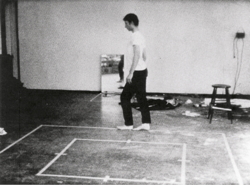 Bruce Nauman, Walking in an Exaggerated Manner around the Perimeter of a Square, (video still) 1968 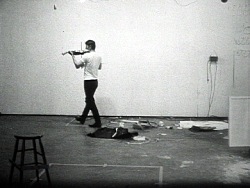 Bruce Nauman, Playing a Note on the Violin While I Walk around the Studio, (video still) 1968 To be repeated continuously. Courtesy Electronic Arts intermix, New York. 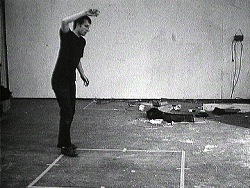 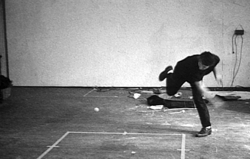 Bruce Nauman, Bouncing Two Balls Between the Floor and Ceiling with Changing Rhythms, (video still) 1967-68 To be repeated continuously. Courtesy Electronic Arts intermix, New York. The sound in the film Bouncing Two Balls between the Floor and Ceiling with Changing Rhythms, 1968, in which Nauman performs a sort of athletic version of the children’s game of jacks, appears at first to be only incidental but turns out to be focus of the piece, sustaining the structure and rhythm of the performance. In the interview with Willoughby Sharp Nauman recalls : « At a certain point I had two balls going and I was running around all the time trying to catch them. Sometimes they would hit something on the floor or the ceiling and go off into the corner and hit together. Finally I lost track of them both. I picked up one of the balls and just threw it against the wall. I was really mad, because I was losing control of the game. I was trying to keep the rhythm going, to have the balls bounce once on the floor and once on the ceiling and then catch them, or twice on the floor and once on the ceiling. There was a rhythm going and when I lost it that ended the film. My idea at the time was that the film should have no beginning or end : one should be able to come in at any time and nothing would change. » — (Bruce Nauman, quoted in Willoughby Sharp, Bruce Nauman, Avalanche 2, Winter 1971, pp. 28-29) — (Coosje van Bruggen, Sounddance, In Bruce Nauman, Edited by Robert C. Morgan, Baltimore Mar. / London : The John Hopkins University Press, 2002, pp. 53-54) Bouncing Two Balls Between the Floor and Ceiling with Changing Rhythms : La caméra est fixe, placée assez bas et pointant vers le sol. Bruce Nauman fait rebondir deux balles au centre d'un carré matérialisé par des rubans adhésifs au sol. Il les jette en s'efforçant de conserver une posture spécifique, mais les balles ricochent sans qu'il puisse en contrôler le mouvement. Tous les défauts techniques ou les imperfections de la réalisation sont conservés. On y voit l'artiste s'essouffler graduellement et perdre progressivement le contrôle de la situation et de son propre corps. |
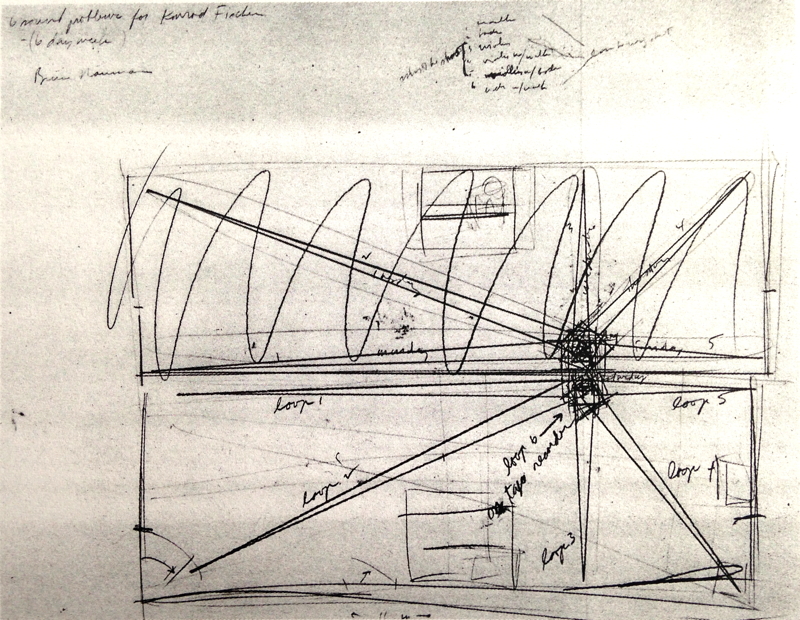
Bruce Nauman, Study for Six Sound Problems for Konrad Fischer, 1968
Nauman’s first body work was done at the University of California at Davis in 1965 while he was still a graduate student. He gave a performance resembling calisthenics. For thirty minutes he put himself through a series of bodily exercises : standing, leaning, bending, squatting, sitting and lying down. It was easier to continue this work alone in his Pasadena studio so he did these performances in front of a 16mm camera that he generally operated by himself. A number of shorts of straightforward simple activities like Bouncing a Ball, Playing a Violin, Pacing in the Studio, and Pacing followed. Even the more artificially structured events like dancing on a taped square on his studio floor, Nauman executes in the most natural way, giving an apppearance of studied relaxation.— (Willoughby Sharp, Body Works, Avalanche, Fall 1970) |
During the winter of 1967-1968 Nauman made four black-and-white films of activities carried out in a studio in Mill Valley that he had sublet from his teacher William T. Wiley : included Playing a Note on the Violin While I Walk Around the Studio, and Bouncing two Balls between the Floor and Ceiling with Changing Rhythms. Nauman remembers at the time telling a friend who was a philosopher that he imagined him spending most of his time at a desk, writing. But in fact his friend did his thinking while taking long walks during the day. This made Nauman conscious of the fact that he spent most of his time pacing around the studio drinking coffee. And so he decided to film that — just the pacing. — (Coosje van Bruggen, Sounddance, In Bruce Nauman, Edited by Robert C. Morgan, Baltimore Mar. / London : The John Hopkins University Press, 2002, p. 47) |
| In many respects, Nauman has always been investigating the central issues of artistic activity. This began with his first films in 1967 and 1968, such as Art Make-Up, Thighing, or Dance or Exercise on the Perimeter of a Square (Square Dance), and continued with videos dating from 1968 and 1969 such as Bouncing in the Corner #1, or Violin Tuned D.E.A.D.. Elementary experimental gestures in the form of actions repeated in a studio, then filmed, allow Nauman to try out the modalities of bodies acting in space, the limits of relevance of an action, studio work, or even the body as source material for works. TO ME IT’S A QUESTION OF GOING TO THE STUDIO, DOING EVERYTHING THAT INTERESTS ME, AND THEN TRYING TO FIND A FORM OF PRESENTATION THAT CAN LEAD TO OTHER PEOPLE REALISING WHAT THE WORK’S ABOUT WITHOUT NEEDING TOO MANY EXPLANATIONS. — (BRUCE NAUMAN –WILLOUGHBY SHARP,) Right from the start, I tried to see if I could do something that would produce this effect. An art that could rise up like that all of a sudden, […] a kind of intensity that’s not exposed to judgement or appreciation. From the beginning I was trying to see if I could make art that . . . was just there all at once. Like getting hit in the face with a baseball bat. Or better, like getting hit in the back of the head. You never see it coming; it just knocks you down. . . . The kind of intensity that doesn’t give you any trace of whether you’re going to like it or not. — (Bruce Nauman) The systematic repetition of a sound, a note played on a violin, a footstep or the striking of a ball can also give Nauman the means to structure time in modes that change from one work to another: repetitiveness, asynchronicity, duration, etc. The almost nothing, the instant that is stretched-out or, on the contrary, densified – these are among the issues that are to be found in the works of the period. Nauman is well known for his interest in Cage and Samuel Beckett, but also La Monte Young and Terry Riley. The availability of portable video equipment in the late 1960s opened up a new range of possibilities, not only as a means of recording performances, but also allowing him to experiment with sound, language, rhythms of text, audience perception and participation. Further advancements in audio-visual technology contributed to the development of the video installation, an art-form that Nauman helped establish and continues to exploit. | À bien des égards, Bruce Nauman mène depuis toujours une investigation sur les enjeux de l’activité artistique elle-même. Cette enquête débute avec la réalisation des premiers films en 1967 et 1968 comme Art Make-Up, Thighing, ou Dance or Exercise on the Perimeter of a Square (Square Dance), puis se prolonge dans les vidéos de 1968 et 1969 telles que Bouncing in the Corner #1 ou Violin Tuned D.E.A.D.. Des gestes élémentaires expérimentés sous la forme d’actions répétées en atelier et filmées, permettent à Nauman d’éprouver les modalités du corps intervenant dans l’espace, des limites de pertinence d’une action, du travail en atelier, voire du corps comme matériau premier de l’œuvre. IL S’AGIT POUR MOI D’ALLER DANS L’ATELIER, DE FAIRE TOUT CE QUI PEUT M’INTÉRESSER, ET ENSUITE D’ESSAYER DE TROUVER UNE FORME DE PRÉSENTATION QUI PUISSE CONDUIRE D’AUTRES PERSONNES À RÉALISER LES ENJEUX DE L’ŒUVRE SANS QU’ELLES AIENT BESOIN D’UN TROP GRAND NOMBRE D’EXPLICATIONS. — (BRUCE NAUMAN – WILLOUGHBY SHARP) Dès le début, j’ai essayé de voir si je pouvais réaliser quelque chose qui produirait cet effet. Un art qui surgirait comme ça d’un coup. (…) Une espèce d’intensité qui se s’expose pas au jugement ou à l’appréciation. — (Bruce Nauman, interview avec Joan Simon) La répétition systématique d’un son, note de violon, pas ou frappe de balle, offre également à l’artiste le moyen de structurer le temps selon des modes qui ont pu changer au fil des pièces : répétitivité, asynchronie, durée... Le presque rien, l’instant étiré ou au contraire densifié font partie des enjeux des œuvres d’alors. On sait l’intérêt de Nauman pour les œuvres de Cage, de Samuel Beckett mais aussi de La Monte Young et Terry Riley. |
Music(Edit)
Music plays a role in a lot of my work... even when there is no music. — (Bruce Nauman)
| NAUMAN - PLAYING VIOLIN Nauman’s Violin Film #1 (Playing the Violin as Fast as I Can) (1967-68) and Playing a Note on the Violin While I Walk around the Studio (1967-68) feature the artist engaged in repetitive, banal activities. Both works evoke the monotony of rudimentary instrumental practice and, at the same time, contemporary minimalist compositional tendencies — (Seth Kim-Cohen, In the Blink of an Ear - Toward a Non-Cochlear Sonic Art, New York - London : Continuum, 2009, p. 213) « [In] the Violin film, I played the violin as long as I could. I don’t know how to play the violin, so it was hard, playing on all four strings as fast as I could for as long as I could. I had ten minutes of film and ran about seven minutes of it before I got tired and had to stop and rest a little bit and then finish it. […] My fingers got very tired and I couldn’t hold the violin anymore. — (Bruce Nauman, quoted in Willoughby Sharp, Nauman Interview, Arts Magazine, March 1970) Nauman blurs distinctions between music and noise, and again poses the question of where practice ends and performance begins. In Playing a Note on the Violin While I Walk around the Studio, 1968, his original intention was « to play two notes very close together so you could hear the beats in the harmonics. […] The camera was set up near the center of the studio facing one wall, but I walked all around the studio, so often there was no one in the picture, just the studio wall and the sound of the footsteps and the violin » (Bruce Nauman, quoted in Willoughby Sharp, Nauman Interview, Arts Magazine, March 1970, p. 27). The sound is fast, loud, distorted, and out of sync, but it is noticeable until the end of the film. Nauman quietly walks out of the frame in the knowledge that, as John Cage put it, « There is no such thing as an empty space or an empty time. There is always something to see, something to hear » (John Cage, from Silence : Lectures and Writings by John Cage, Middletown Conn. : Wesleyan University Press, 1976, p.8). It was again Cage who made Nauman aware of the possibilities of playing with sounds « that are notated and those that are not ». In his book Silence, Cage explained that « those that are not notated appear in the written music as silences, opening the doors of the music to the sounds that happen to be in the environment » (Cage, from Silence). When Nauman steps outside the frame, the viewer’s sense fo his own environment is height-ened, while the action in the film is reduced to « white noise », vaguely present in the background ; the involvement of the spectator with the performance is nearly broken. When he made this film, Nauman did not know how to play the violin, which he had bought only a month or two earlier. « I play other instruments, but I never played the violin during the period of time that I had before the film I started diddling around with it ». [... Nauman knew Reich’s Violin Phase (1967), in which « one basic pattern is played simultaneously by several violonists in a variety of different phase relationships ». This piece, and Stockhausen’s experiments with fast-paced tempi, had a particular impact on the two works (Playing a Note…, Violin tuned D.E.A.D.) ...] A year later, during the winter of 1968-69, Nauman made the videotape Violin Tuned D.E.A.D. « one thing I was interested in was playing […] I wanted to set up a problem where it wouldn’t matter whether I knew how to play the violin or not. What I did was to play as fast as I could on all four strings with the violin tuned D, E, A, D. I thought it would just be a lot of noise, but it turned out to be musically very interesting. It is a very tense piece ». (Bruce Nauman, quoted in Willoughby Sharp, Bruce Nauman, Avalanche 2, Winter 1971, p. 27) Nauman felt strongly that the important thing in doing these performances was to « recognize what you don’t know, and what you can’t do », and as a amateur never to allow himself to slip into traditional music, theater, or dance, where he would put himself in the position of being compared with professional performers in those fields. Nauman believed that if he chose the right set of circumstances and structure, was serious enough about his activities, and worked hard art at it, his performance would have merit. His intentions and attitude would turn the performance into art. John Cage’s Pieces for Prepared Piano of 1940 gave Nauman additional insight into the reinvention of how to play the violin. For this piece Cage had changed the sound of a piano in order to produce music suitable for the dancer Syvilla Fort’s performance of Bacchanale. First Cage had placed a pie plate on the strings, but it bounced around because of the vibrations. Nails, which he had placed inside the piano as well, slipped down between the strings ; however, screws and bolts worked out. In this way, Cage wrote, « two different sounds could be produced. One was resonant and open, the other was quiet and muted » (Cage, quoted in Empty Words : Writings 1973-1978 by John Cage, Middletown Conn. : Wesleyan University Press, 1981, p. 8) By playing the notes D, E, A, D, on the violin as fast as he could, Nauman created a rhythmic structure and notational pattern that, because of its repetition, provided a certain monotonous continuity, [such as, « pacing and rhythmic stamping around the studio »]. Because of the frenetic tempo, the performance was very intense ; Nauman’s screechy manner of playing lacked any melody inflection, and the sounds picked up by the cheap equipment gave the piece a harsh electronic character. Nauman got the idea of playing as fast as he could from the aleatoric directions in certain musical compositions by Karlheinz Stockhausen, especially his 1955-56 Zeitmasse (« Tempi ») for woodwind quintet. […] [... Violin Tuned D.E.A.D. enacts a jumbled cross-reference of the code of Western notation with the code of the English alphabet. Instead of tuning the violin according to harmonic logic, Nauman tunes it according to linguistic logic, facetiously declaring the instrument and, by association, the tradition of Western music embedded in the violin, to be dead — (Seth Kim-Cohen, In the Blink of an Ear - Toward a Non-Cochlear Sonic Art, New York - London : Continuum, 2009, pp. 213-214) ...] In Violin Tuned D.E.A.D., Nauman created a specific kind of environment through sound, and at the same time turned the act of playing into a physical activity that is itself interesting to watch. By turning the camera on its side and his back to the camera, in a static, medium-long shot of the studio, Nauman portrayed himself as an anonymous figure floating horizontally across the screen in defiance of gravity. The performance in Violin Tuned D.E.A.D. would have been a continuous activity were it not for the unintentional mistakes, accentuations, and moments of faltering and tiredness that slowed the tempo from time to time. — (Coosje van Bruggen, Sounddance, In Bruce Nauman, Edited by Robert C. Morgan, Baltimore Mar. / London : The John Hopkins University Press, 2002, pp. 50-52) 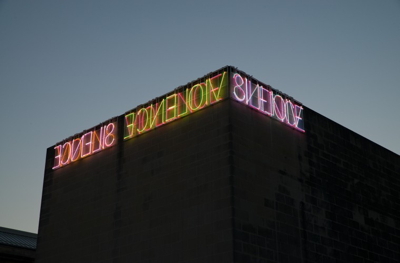 Bruce Nauman, Violins Violence Silence (Exterior Version), 1981 (The Baltimore Museum of Art) 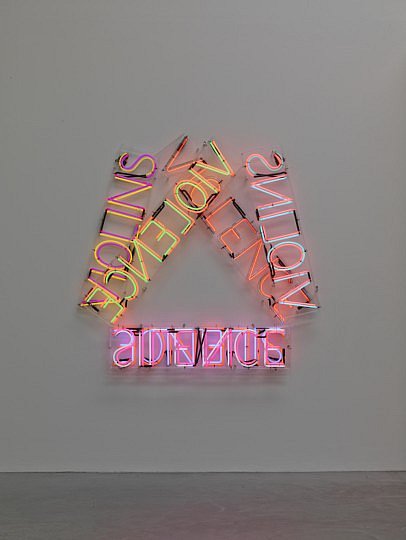 Bruce Nauman, Violins Violence Silence, 157.80 x 166.10 x 15.20 cm, 1981-82 In this work the neon words ‘VIOLINS’, ‘VIOLENCE’ and ‘SILENCE’ each appear twice, once forwards and once backwards, in a triangular composition on the wall. ‘VIOLENCE’ crosses in the centre to create two sides of the triangle; ‘SILENCE’ forms the base; and ‘VIOLINS’ produce two arms rising upwards at either side. The three words have a united rhythm that invites the viewer to speak them aloud. Here, as in so much of his practice, Nauman requires his viewer to be an active participant in the work. The flashing neons present varying combinations of the three words that confuse and blur the relationship between them. | 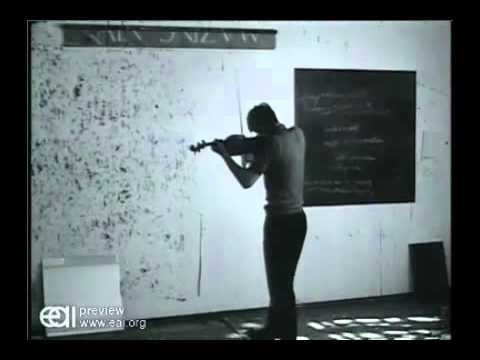 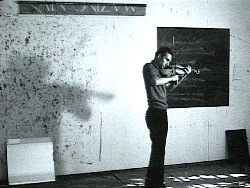 Bruce Nauman, Violin Film # 1 (Playing The Violin As Fast As I Can), (video stills) 1967-68, 10:54 min, b&w, sound, 16 mm film on video [Play the video] (the soundtrack to this film was included in Nauman's Record (1969), a limited-edition vinyl-LP, published by Tanglewood Press – Seven objects) Violin Film # 1 (Playing The Violin As Fast As I Can) est une des nombreuses vidéos réalisées en 1967-68 présentant l'artiste en train de jouer du violon. A l'image de ce qui se passe dans Bouncing Two Balls between the Floor and Ceiling with Changing Rhythms, l'artiste joue le plus vite possible afin d'atteindre la limite de contrôle de son action.  Bruce Nauman, Playing a Note on the Violin While I Walk around the Studio, (video still) 1967-1968, 10 min, b&w, sound, 16 mm film on video Playing a Note on the Violin While I Walk around the Studio est l'enregistrement d'un projet de performance qui ne sera jamais jouée en public. Nauman marche dans l'atelier en jouant de façon répétitive deux notes sur un violon, instrument avec lequel il n'est pas familier. La caméra est placée au centre de l'atelier, en position fixe, tandis que Bruce Nauman sort parfois hors champ. Le son du violon persiste tout au long du film. 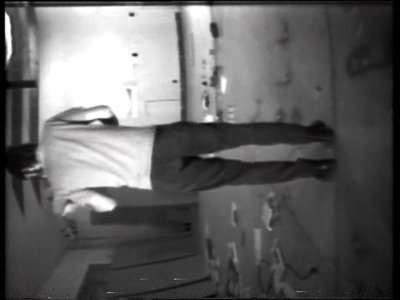 Bruce Nauman, Violin Tuned D.E.A.D., (video still) 1969, 60 min, b&w, sound, mono, 4:3, 16 mm film on video [Play the video] In a closed space, his studio, which could be the whole world as a backdrop, Bruce Nauman, fixed horizontally to the floor-wall, plays the chords D.E.A.D. on a violin, creating reverberations which course through the meanders of the mind and collide with the walls of the cell. This escalation of sound, a vast echo chamber, evokes one of his sculptures, produced in 1981: Diamond Africa With Tuned Chair D.E.A.D.. A musical chair is turned upside down on the ceiling : a reprise of the video Violin Tuned D.E.A.D., now with the legs of the chair (and not the strings of the violin) tuned to these notes that sound a death knell with a geopolitical significance that we are made of to be very much aware of : the legs of the suspended cast-iron chair sound the same notes when struck. Isolated, imprisoned, it is also capable of playing its own funeral march. In a way, Bruce Nauman uses his body like the chair, as a material which he can manipulate and around which the sound spreads out, extending between life and death, in revolution. — (Stéphanie Moisdon) Un an après Playing a Note on the Violin While I Walk around the Studio, Bruce Nauman enregistre la bande intitulée Violin Tuned D.E.A.D. En jouant les notes D (Ré), E (Mi), A (La), D (Ré) aussi vite qu'il peut, l'artiste crée une structure rythmique qui en raison de la répétition engendre une continuité monotone. Le tempo frénétique rend la performance très intense. Par le cadrage et le positionnement de la caméra, Nauman, qui joue de dos, se montre comme une figure anonyme. — — Dans un espace clos, son studio, qui pourrait être le monde entier comme fond de décor, Bruce Nauman fixé au sol-mur à l'horizontale fait vibrer les accords de la M.O.R.T sur un violon. Réverbérations qui parcourent les méandres de l'esprit et qui se heurtent aux parois de la cellule. Cette escalade sonore, vaste chambre d'échos, renvoie en résonance à l'une de ses sculptures réalisées en 1981 : Diamond Africa With Tuned Chair D.E.A.D (Afrique Diamant Avec Chaise Accordée Ré Mi La Ré, où la succession des lettres en anglais compose encore une fois le mot DEAD : MORT). Une chaise musicale est renversée au plafond. Isolée, emprisonnée, elle est également capable de diffuser son propre hymne funèbre. D'une certaine manière, Bruce Nauman se sert de son corps comme de la chaise, comme d'un matériau qu'il peut manipuler, autour duquel le son se déploie, s'étend entre la vie et la mort, en révolution. — (Stéphanie Moisdon) 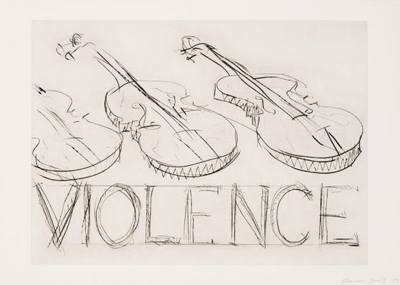 Bruce Nauman, Violins Violence, 1985 See also : VIOLINS VIOLENCE SILENCE (1981-1982) and Violins Violence Silence (Exterior Version) |
Sound(Edit)
| NAUMAN - RECORDED SOUND The first time Nauman gave directions for particular sounds to be incorporated as an element in a sculptural work was in a concept for a piece that was never executed but is preserved in a drawing of 1966. On it he noted : « Cry to me, cry to me, yellow neon at bottom pile of felt pads with letters cut out — neon light at bottom ; if pad is say 5’ or 6’ square, can’t see light at bottom except what light shining up from the holes — (could be lead rather than felt) ; need 7’’ of felt, 5/16’’ per layer, say 22 layers : if 6 sq. cost $8 for 9x12, or $4 per layer, cost $88 for sufficient layer ». Instead of presenting a piece of information, he employed an imperative that could be a fragment of a rock’n’ roll lyric, as he had in Love Me Tender, Move Te Lender, the pun on the title of the Elvis Presley song. In 1968 Nauman realized a piece with hidden sound and described it in a drawing with this notation : Concrete Tape Recorder Piece — « Tape recorder with a tape loop of a scream wrapped in a plastic bag and cast into the center of a block of concrete : weight about 650 pounds or 240 kg ». The theatrical gesture of the muffled scream offsets the minimal form of this piece. The idea shows similarities with Nauman’s time-capsule pieces, such as Storage Capsule for the Right Rear Quarter of My Body, 1966. A reversal of expectations occurs as the volume of air enclosing the recorded scream is solidified in concrete, giving the piece a sculptural presence. By sealing off the sound, Nauman forces the spectator to imagine the concept and therefore to thing about the piece rather than simply be attracted by its formal qualities. This proposal and another from the same year — for an unrealized stack piece that would conceal memorabilia from his own life, such as photographs and pocket things, between heavy steel plates — bring to mind Marcel Duchamp’s With Hidden Noise, 1916. — (Coosje van Bruggen, Sounddance, In Bruce Nauman, Edited by Robert C. Morgan, Baltimore Mar. / London : The John Hopkins University Press, 2002, pp. 53-55) 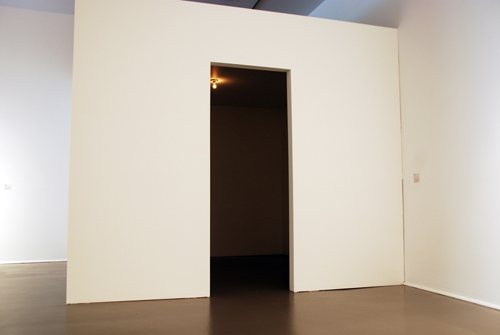 Bruce Nauman, Get Out of My Mind Get Out if This Room, 1968 Deux haut-parleurs dissimulés dans les murs d’une salle vide s’adressent au visiteur qui entend quelques bruits de pas, puis deux exclamations répétées inlassablement (« Get out of my mind, Get out of this room »), sur un ton alternativement enjoué et menaçant. Le message intime donc au spectateur l’ordre de sortir de la pièce; prenant ainsi le contre-pied de l’exigence classique de l’œuvre d’art qui requiert d’être contemplée, l’œuvre invite le spectateur à la fuir. Ici encore, la voix est d’autant plus comminatoire qu’elle est invisible et qu’elle joue sur différents registres de tonalités, tantôt douce, tantôt inquiétante. Musical Chairs (1983) « I’ve also used the children’s game « musical chairs » a number of times. The simplest version was Musical Chair (Studio Piece) in 1983, which a chair hanging at the outside edge of a circumference of suspended steel Xs. So, when the Xs swing or the chair swings, they bang into each other and actually make noise — make music. But of course it was more than that because musical chairs is also a cruel game. Somebody is always left out. The first one to be excluded always feels terrible. That kid doesn’t get to play anymore, has nothing to do, has to stand in the corner or whatever. » — (Bruce Nauman) 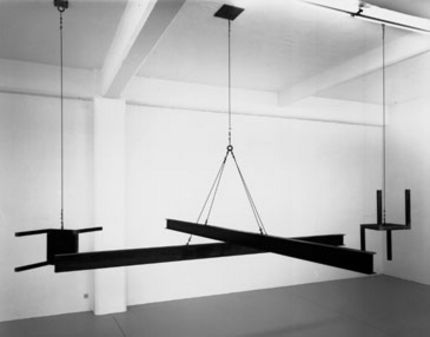 Bruce Nauman, Musical Chairs, 1983.  Bruce Nauman, Musical Chairs, 1983, at Herbert Foundation, 2013. 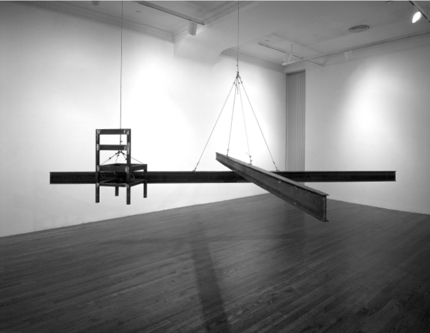 Bruce Nauman, Musical Chair, 1983, Courtesy Sperone Westwater Gallery, New York. | 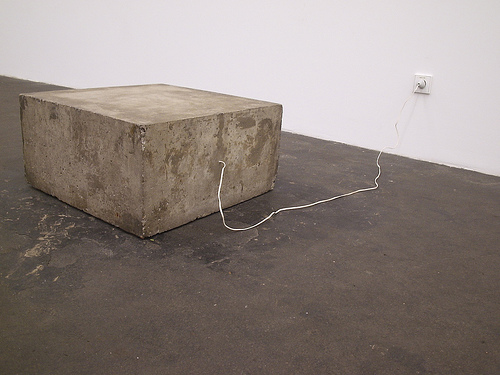 Bruce Nauman, Concrete Tape Recorder Piece, 1968 Nauman has always been interested in the potential of sound to act as an art piece - one early work is just the sound of his voice in a room empty other than a speaker that conveys it. — Get Out of My Mind Get Out if This Room (1968) presents those words and nothing else, the tone changing in a properly tragic reflection on the borders between subject - the auditor is both called on to leave and called upon as listener to attend to the internal workings of the mind as expressed audiospatially in the room. […] Several of the early films and all the videos [by Nauman] feature sound as part of their making, a function of the recording process - it is « just there ». Nauman asserts that both film and video were methods of displacing the need for live performance and a way of presenting such « as it happened ». [Nauman’s] interviews are liberally seasoned with references to his attachment to Philip Glass, La Monte Young, Steve Reich and Terry Riley [for instance in Please Pay Attention Please - Bruce Nauman's Words, Writings and Interviews, edited by Janet Kraynak, MIT Press, 2003 - [pdf download] ], whose repetitive exploration of infinitesimal change seems to have suggested a methodology for his videos as well as his other installation work. Nauman also looked towards composers such as Bela Bartok and the pioneering free improviser Lennie Tristano. These repeated claims of musical influence surface directly in the violin piece of 1968, but also indicate the importance of sound as a temporally structuring device - minimalist music was the first music, other than some experiments by Erik Satie and John Cage, to take its structuring of time as mission […]. Nauman would maintain the sound portion of his video recording as a vital marker of rhythm, and this sound would also spatialize the monitor installation. — (Paul Hegarty, Rumour and Radiation : Sound in Video Art, chapter two - Bruce Nauman and the Audiospatial, Bloomsbury Academic, 2015, pp. 34-35) Days (2009) Bruce Nauman’s Days (2009) was created for, and debuted at, the 2009 Venice Biennale, where the artist represented the United States with the solo exhibition Bruce Nauman: Topological Gardens. Days is a “sound sculpture” consisting of a continuous stream of seven voices reciting the days of the week in random order. Fourteen suspended speakers are installed in two rows with one voice emanating from each pair of speakers as the visitor passes between them. There are men’s voices and women’s voices, old and young. Some speak swiftly, others with pause, each with his or her own cadence. The collection of distinctive voices produces a chorus—at times cacophonous, at others, resonant—and creates a sonic cocoon that envelops the visitor. The work invokes both the banality and the profundity of the passing of each day, and invites reflection on how we measure, differentiate, and commemorate time. — [Source] — [Video document (2009)] 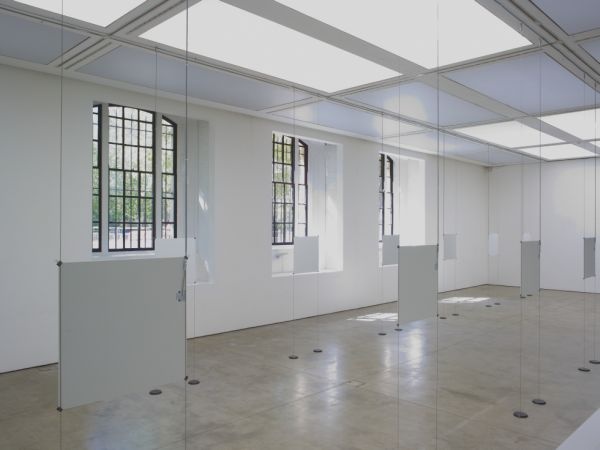 Bruce Nauman, Days (installation view - Photo Stephen White - ICA London, 2012), 2009. One audio source consisting of seven stereo audio files, fourteen speakers, two amplifiers, and additional equipment. Dimensions variable. Audio (fourteen channels). Continuous play 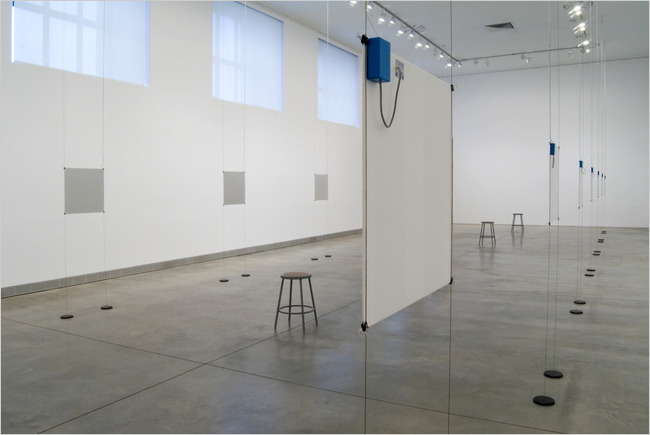 Bruce Nauman, Days and Giorni Two sound pieces (above, “Giorni”) at the Philadelphia Museum of Art, 2009. Photo Jason Wierzbicki. Each consists of recordings of seven people reciting the days of the week and the equipment necessary to make them heard, either in English (“Days”) or Italian (“Giorni”). Both create corridors of sound and deliver epiphanies about time, space and humanity. 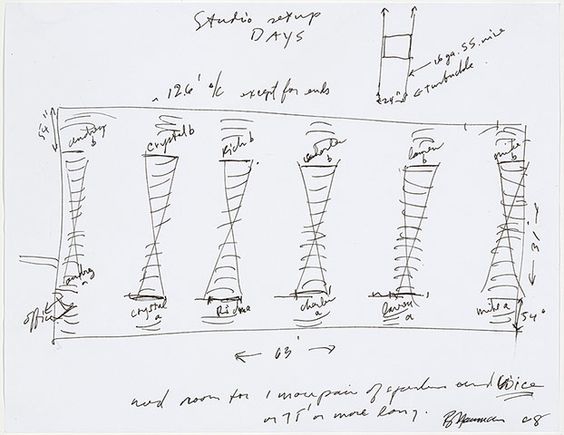 Bruce Nauman, Days, studio set-up |
Sound loop(Edit)
| NAUMAN - LOOPED SOUND (Click to enlarge) 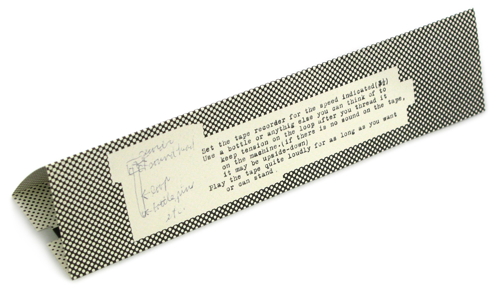 Bruce Nauman, Footsteps, in S.M.S. Portfolio #5, Ink on heavy paper with magnetic tape, 2 1/2 x 10 3/4 inches 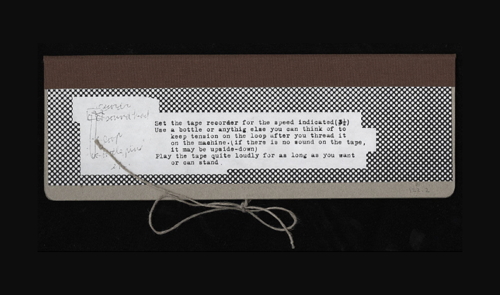 Bruce Nauman, Footsteps, The Letter Edged in Black, 1968, 7.25 w x 11.75 h inches, Edition of 2000 | A loose piece of magnetic tape (featuring ambient sounds of walking) wrapped around a folded card with the following instructions: Set the tape recorder for the speed indicated (3½) Use a bottle or anything else you can think of to keep tension on the loop after you thread it on the machine. (if there is no sound on the tape, it may be upside down). Play the tape quite loudly for as long as you want or can stand. — (Originally produced as part of the SMS portfolios (n°5)) Despite the implications suggested by the instructions, the audio is not confrontational and the reference to as long as you “can stand” seem to refer more to the listener’s attention span rather than tolerance. Likewise the instruction to “play the tape quite loudly” seems to refer to the fact that the tape is in fact rather quiet. — Eric Lanzillotta Released in 1968, the SMS portfolio represented a collaboration between some of the most important artists of the 20th century. Centered around a loft on Manhattan's Upper West Side rented and maintained by the American Surrealist William Copley, SMS (a coy abbreviation for "Shit Must Stop") was an open-ended collective that epitomized the community ethos of the late 1960s. Frequented by artists, curators, performers and composers both accomplished and aspiring, Copley's loft became renowned for its utopian morale and hospitable working conditions, which included "a buffet perpetually replenished by nearby Zabar's Delicatessen, an open bar, and a pay phone with a cigar box filled with dimes." — (Carter Ratcliff, "SMS: Art in Real Time," from SMS: A Collection of Multiples. Exhibition catalog. Published by Reinhold-Brown Gallery, NY. Oct. 1988) |
Sound amplification(Edit)
NAUMAN - AMPLIFIED SOUND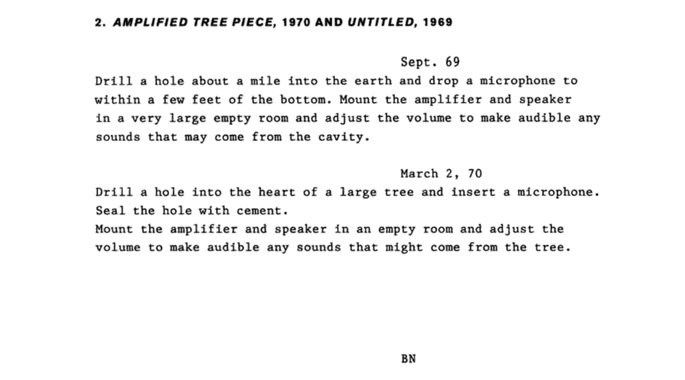 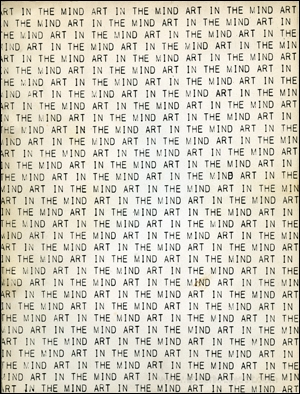 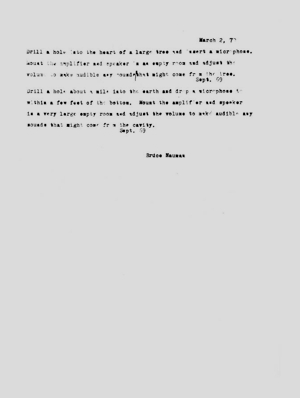 Nauman's page into the Art of Mind's catalogue, 1970 (Click to enlarge) | Those two proposal pieces were Nauman’s contribution to the exhibition, "Art in the Mind" at the Allen Memorial Art Museum, Oberlin College (April 17 - May 12, 1970). The exhibition, organized by Athena Spear, consisted only of the catalogue, which includes photocopied proposals, instructions, diagrams, and charts from the fifty invited artists. Unbound pages were also "mounted on wall of a well frequented corridor of the art building", as Spear writes in the catalogue ; some of the works, she adds, "were executed by students of the Oberlin College Art Department". — (In Please Pay Attention Please - Bruce Nauman's Words, Writings and Interviews, edited by Janet Kraynak, MIT Press, 2003, p. 50 - [pdf download]) |
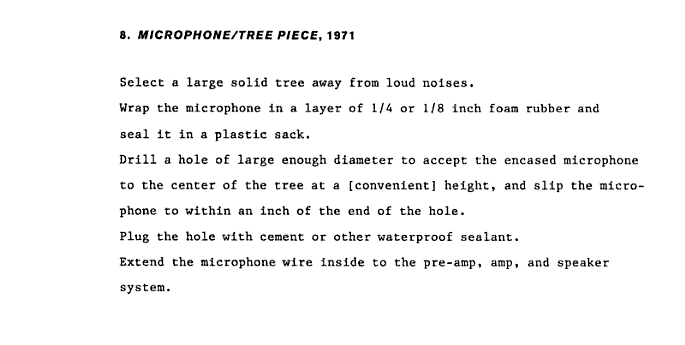 Expanding upon the earlier Amplified Tree Piece (1969), this instruction for a sculptural installation, according to the catalogue raisonné entry, was acquired and built by the Grinstein family in Los Angeles ; however, the tree in which it was installed died soon after. — (In Please Pay Attention Please - Bruce Nauman's Words, Writings and Interviews, edited by Janet Kraynak, MIT Press, 2003, p. 61 - [pdf download]) Microphone / Tree Piece calls for sinking a microphone deep inside a tree sending the audio signal back to the gallery. — Joan Simon — "Did you think this could be monitored, or was it about conceiving a mental space ?" — Bruce Nauman — "Well, it worked. At least two people heard it. Stanley and Elyse [Grinstein] said you could hear leaves blowing, people talking, and if everything was still and no one was in the yard near the tree, just a quiet hummmm". [Source] Note : Stanley Grinstein was one of the founders of the pioneering workshop Gemini G.E.L. (Graphic Editions Limited) in Los Angeles in 1966. | (Click to enlarge)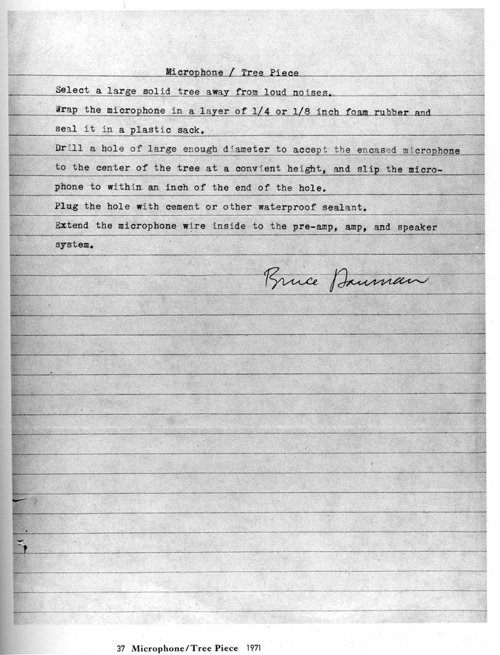 |
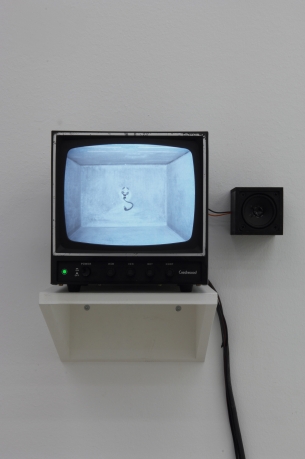  Audio-Video Underground Chamber (1972-74) This piece called for the sinking of a tomb-sized concrete box buried underground at a location, and equipped with a camera and a microphone that channel the live audio and video signals back to the gallery room. The actual existence of the buried cabin is concretized only in the viewers' imagination by means of the live broadcast and two of Nauman's explanatory, blueprint drawings. Image and sound call up associations with the psychic and existential borderline areas around which Nauman's art often revolves, with feelings of isolation and claustrophobia, experiences of loss of communication and of orientation, and traumas such as that of being buried alive. 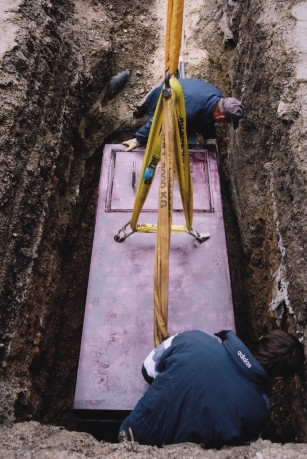 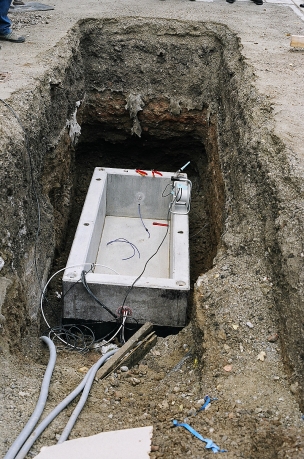 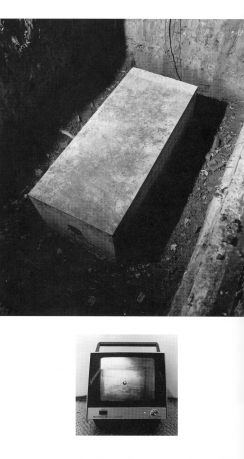 (Pictures : Museum Moderner Kunst Stiftung Ludwig Wien) For his Audio-Video Underground Chamber, Bruce Nauman constructed a concrete chamber beneath the Museum Moderner Kunst Stiftung Ludwig in Vienna. For the duration of the exhibition, and as a premier showing, the sparse signals from the Austrian museum will be transmitted via camera and microphone into the K21 Ständehaus. It is impossible to enter this visually abstract space or to locate it precisely. Like Nauman’s models of tunnels and drawings, the chamber is a stimulus to reflect upon imaginary and real spaces. |
Acoustics(Edit)
| NAUMAN - ACOUSTIC WALLS In December 1969, Nauman constructed his first Acoustic Walls at the Galerie Ileana Sonnabend in Paris. « It was a large L-shaped piece covering two walls of her Paris gallery. It was flush with the wall of the gallery, and had very thing speakers built into it. Two different tapes were played over the speakers : one was of exhaling sounds, and the other alternated between pounding and laughing. You couldn’t locate the sound. That was quite a threatening piece, especially the exhaling sounds » — (Bruce Nauman, quoted in Willoughby Sharp, Nauman Interview, Arts Magazine, March 1970, p. 26). The false wall, 9 feet high and 12 feet long on each wing of the L shape, served no support function and so was built roughly to create a sculptural presence in the room. In most of the Acoustic Walls installations, sound is used not only to disorient but also to impart a psychological impact to otherwise neutral surroundings. The advantage of using sound in this way is that it does not cover up « true » materials, something that must be done to create a sculptural presence in the gallery. To reinforce both their tactility and their ambiguity — are these false walls art, or are they part of construction work being done in the gallery ? — most of these walls are smooth on the inside but rough and unfinished on the outside. In the 1969-70 Acoustic Wall, Nauman shifts the emphasis from visual experience to physical involvement. He explained his intent in such works : « When the corridors had to do with sound damping, the wall relied on soundproofing material which altered the sound in the corridor and also caused pressure on your ears, which is what I was really interested in : pressure changes that occurred while you were passing by the material. And then one thing to do was to make a V. When you are at the open of the V, there’s not too much effect, but as you walk into the V the pressure increases quite a bit, it’s very claustrophobic. » — (Bruce Nauman, quoted in Willoughby Sharp, Bruce Nauman, Avalanche 2, Winter 1971, p. 23)  Bruce Nauman, Acoustic Pressure Piece, 1971 […] As hard as it is to measure the impact of « emotional overload » on the participants, it is as senseless, in accordance with Nauman’s intent, to attempt to describe the Acoustic Wall pieces, which « relies in words less and less ». Already in 1970 Nauman had written that « it has become really difficult to explain the pieces. Although it’s easier to describe them now, it’s almost impossible to explain what they do when you’re here. […] And the pieces increasingly have to do with physical or physiological responses » — (Bruce Nauman, quoted in Willoughby Sharp, Nauman Interview, Arts Magazine, March 1970, p. 26). Information from two sources, touching and hearing, disorients and confuses the participants in the Acoustic Wall installations. Sometimes the sources are inseparable ; at other times they do not align at all. The artist can then restrict the participants physically, guiding their experiences. — (Coosje van Bruggen, Sounddance, In Bruce Nauman, Edited by Robert C. Morgan, Baltimore Mar. / London : The John Hopkins University Press, 2002, pp. 64-65) Other reference : http://notations.aboutdrawing.org/category/bruce-nauman/ 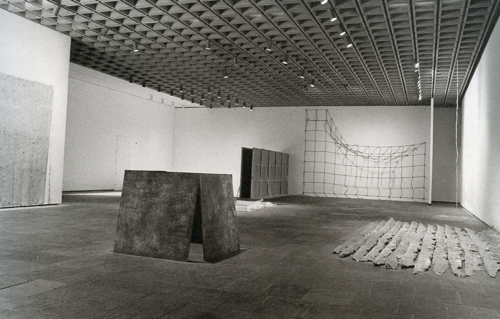 Bruce Nauman, Performance Corridor, 1969, wallboard and wood, 96 × 240 × 20 in. (243.8 × 609.6 × 50.8 cm), Anti-Illusion : Procedures/Materials exhibition, Whitney Museum of American Art Performance Corridor (1969), included in the collective exhibition Anti-Illusion : Procedures/Materials, which was held at The Whitney Museum of American Art in May 19, 1969-July 6, 1969, began as a prop for Nauman’s videotape Walk with Contrapposto (1968). The artist wanted to record himself walking back and forth in a narrow space, so he constructed two freestanding walls, each 8 feet high and 20 feet long. When placed 20 inches apart with the ends abutting a wall, they formed a closed and quite narrow corridor. He remade this makeshift corridor for the Whitney, with the implicit invitation to viewers to enter and experience the cramped space. Indeed, the critic Peter Schjeldahl described Performance Corridor at the time as « ruthless », a « somber corridor » that induces « claustrophobic discomfort ». — (Neal Benezra, Surveying Nauman, In Bruce Nauman, Edited by Robert C. Morgan, Baltimore Mar. / London : The John Hopkins University Press, 2002, pp. 125-126)  Bruce Nauman, Performance Corridor, 1969, wallboard and wood, 96 × 240 × 20 in. (243.8 × 609.6 × 50.8 cm), Anti-Illusion : Procedures/Materials exhibition, Whitney Museum of American Art 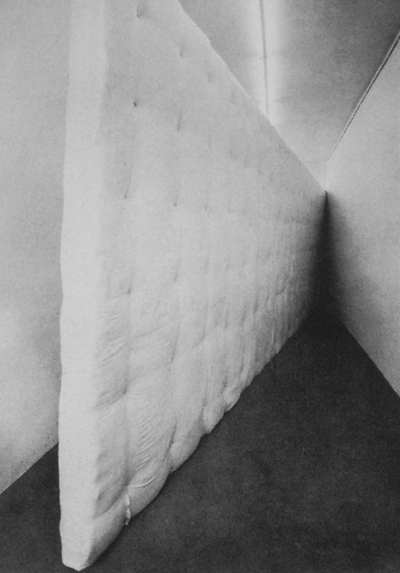 Bruce Nauman, Acoustic Wall, 1969 — Konrad Fischer gallery, Zürich Bruce Nauman [...] warps our habitual way of hearing and its capacity to inform our sense of proper physical location in space by removing or reflecting the ambient sound along his thirty-foot wall constructed from acoustical insulation. When we walk past Nauman's wall, the presence of ambient sound in one of our ears and its absence from the other alters our customary sense of balance. — (Suzanne Delehanty, Soundings, In Soundings / Neuberger Museum, catalog of the collective exhibition, State University of New York at Purchase, 20 sept - 23 dec 1981, p. 11 & p. 72) | (Click to enlarge)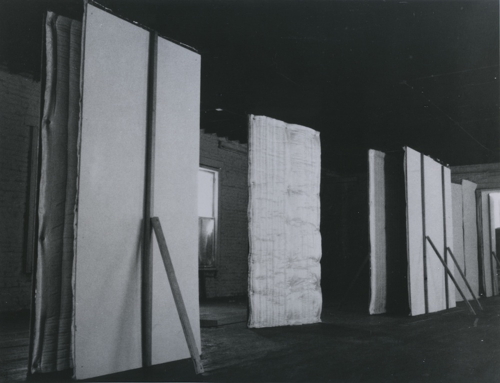 Bruce Nauman, Acoustic Pressure Piece, c. 1969, Installation at the artist’s studio, Pasadena, CA  Bruce Nauman, Acoustic Pressure Piece, 1971, Installation at the Castelli Gallery, New York, 1973 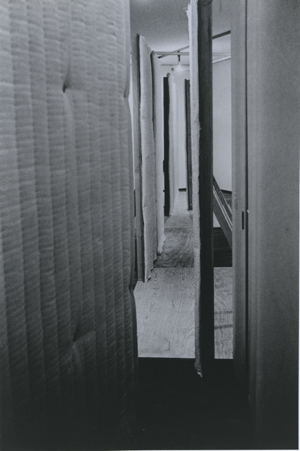 Bruce Nauman, Acoustic Pressure Piece, 1971, Installation at the Castelli Gallery, New York, 1973 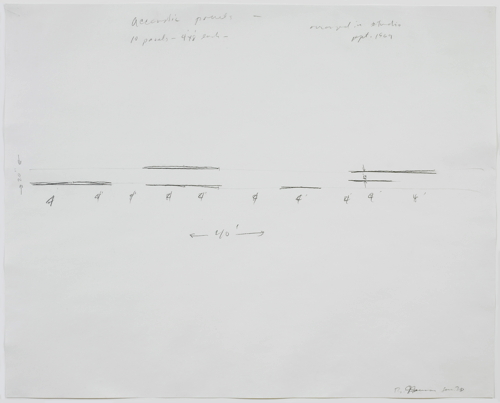 Bruce Nauman, acoustic panels / 10 panels – 4′ x 8′ each / arranged in studio / sept. 1969, 1970 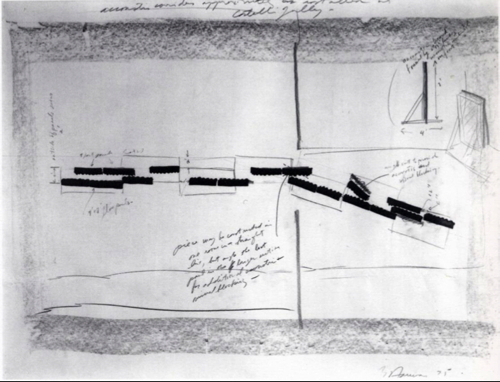 Bruce Nauman, Acoustic Pressure Piece, drawing, 1971 Dans Acoustic Pressure Piece (ou Acoustic Corridor), 1971, un couloir aux parois recouvertes de matériaux d’insonorisation modifie le son, crée des différences de pression acoustique et réduit le champ visuel. 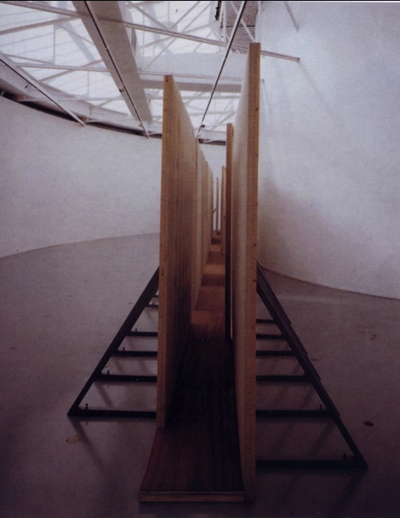 Bruce Nauman, Acoustic Corridor, 1971 — Musée d'Art Moderne de la Ville de Paris 1990 (Click to enlarge)  Bruce Nauman, Body Pressure, 1974 |
Repetition & Phasing / Steve Reich(Edit)
| bouncing backward into a corner for over an hour Nauman did his last live performance in 1969 [titled Bounce or Bouncing into a Corner], during the exhibition Anti-Illusion : Procedures/Materials, held at the Whitney Museum of American Art in New York from May 19 to July 6. The Bounce performance was a part of the "Four Evenings of Extended Time Pieces and a Lecture" programme, and took place on May 26, 1969. For an hour, the performers in the piece — Nauman, his wife Judy, and the dancer Meredith Monk — stood in different corners of the space, facing the audience. Over and over they left themselves fall back, then pushed themselves off the walls of the corner, a foot and a half away, bouncing back to the point where they would nearly lose their balance — [see the video work Bouncing in the Corner No. 1 ]. The effect of this rigorous, physically exhausting exercise, "bouncing backward into a corner for over an hour", was intensified by the thumping sound it produced. Because the performers could not see each other, they were in varying degrees in and out of sync both with each other and with the pounding sounds they produced. Nauman employed a similar effect in his 1985 neon pieces on sex and power. Je pense que [Bruce Nauman] a le sens musical. Je me rappelle avoir participé à une de ses performances qui avait une dimension musicale tout à fait fascinante. C’était en 1969. Nous nous trouvions dans une salle au deuxième étage du Whitney Museum of American Art. Bruce, sa femme et moi-même nous nous tenions debout chacun à un coin de la pièce, le dos au mur. Notre tâche consistait uniquement à se laisser tomber en arrière, le dos contre le mur, à se laisser à nouveau tomber en arrière, puis à se redresser… et ainsi de suite pendant une heure. Le bruit sourd des corps se laissant tomber et les configurations rythmiques et visuelles changeaient continuellement parce que chacun de nous tombait de façon différente et à intervalles différents. En repensant à cette performance aujourd’hui, je m’aperçois que sa conception était musicale. […] Nous ne tenions pas compte d’une mesure précise. Chaque personne pouvait tomber en arrière et se redresser quand elle le voulait. L’ensemble produisait quelque chose que l’on pourrait rapprocher d’un jeu de percussion, d’un morceau de batterie. — (Meredith Month, Entretien avec Christine van Assche, novembre 1996, In Bruce Nauman, Image-Texte 1966-1996, Éditions du Centre Georges Pompidou, 1997, pp. 77-78) « Subject Matter » de Dan Graham (qui aborde également la sculpture dite « minimale ») prend pour sujet une performance de Steve Reich et Bruce Nauman pour y repérer un glissement de l’objectalité en art (minimal) vers la perception du champ phénoménologique par le corps du spectateur, assimilé au corps de l’art – à son « sujet » ; matter (le titre de l’article est difficilement traduisible du fait de la polysémie de matter, désignant non seulement la « matière » mais encore le « sujet », au sens de « contenu ») renvoyant aux processus de modification physique de l’objet perçu et changeant formellement dans le temps. La relation sujet/objet, rendue matériellement (corporellement) perceptible, est le « thème » de beaucoup de ses performances, films et installations. — (Vincent Pécoil) | 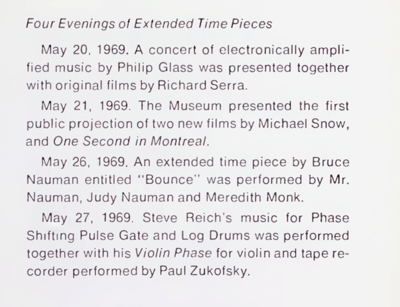 Anti-Illusion : Procedures/Materials, collective exhibition, Whitney Museum of American Art, New York - "Four Evenings of Extended Time Pieces" programme — [Source (The Whitney Review, 1968-1969)] Bruce Nauman : “Well, the first time I talked to anybody about body awareness was in the summer of 68. Meredith Monk was in San Francisco. She had thought about or seen some of my work and recognized it. An awareness of yourself comes form a certain amount of activity and you can’t get it from just thinking about yourself. You do exercises, you have certain kinds of awareness that you don’t have if you read books. So the films and some of the pieces that I did after that for videotapes were specifically about doing exercises in balance. I thought of them as dance problems without being a dancer, being interested in the kind of tension that arises when you try to balance and you can’t…” — (In Avalanche 2, April 1971) The performances of Reich and Nauman, Pendulum Music and Bouncing in a Corner, appear to Dan Graham in his article “Subject Matter” (1969), to flesh out two different modes of subjectivity, one in a state of pulsation and another in a static state of self-presence. — Eric de Bruyn, “Sound Is Material”: Dan Graham in Conversation with Eric de Bruyn, In Grey Room 17, Fall 2004, pp. 108–117) — — My work changed with minimal art, in two ways. Main thing is, I would go more interested in the spectator rather than the performer, and secondly, I got very – and actually, subject matter, I talked about this beautiful Bruce Nauman performance at the Whitney. He, his wife, and Meredith Monk were bouncing off the wall of the Whitney, and making a phasing pattern like Steve Reich, and also, he played the architecture, because you can go anywhere in the architecture and you can hear yourself in relation to the architecture. — (Dan Graham, INTERVIEW BY SABINE BREITWIESER, MOMA New York, November 1, 2011) Dan Graham’s portrayal of Nauman’s performance Bouncing in a Corner [in his essay, Subject Matter], which he attended during the Whitney Museum’s Anti-Illusion exhibition of 1969. In Bouncing into a Corner, three performers used the walls of the museum as a kind of musical instrument or sounding board by dropping their backs against the wall. It was not possible, however, on entering the performance space to see all three members of the performance group at once. Hearing a “discrepancy in the beats,” Dan Graham decided to move around the room, and only then did he discover the presence of a third performer. Graham attempts to describe the transitive quality of this auditory environment : Everybody is shifting in relation to the kinaesthetic, visual, aural, and informational totality of the process... instead of activating and playing upon the audience’s collective or individual tensions, the audience shifts attention as they and the players shift the tensions of their muscular framework… there is no inside or outside to the sound-space or in its relation to the instrumentality… shifting time of performance shifting—shifting the time of the collective relations. Passing to the limit, Nauman’s performances gradually give way to a kind of smoothed space, which no longer possesses the metric properties of a Euclidean geometry but the intensive and directional qualities of a vectorial field. In such a topological space no fixed boundaries and no central position of focus are available to the observer. As Graham writes, the observer has become in-formed by a transformational field of sensory and semantic relations. The space does not contain the performance ; rather it is the performance that constitutes the space: “Everybody is shifting in relation to the kinaesthetic, visual, aural, and informational totality of the process.” — (Eric de Bruyn, Topological Pathways of Post-Minimalism, In Grey Room, Fall 2006, Vol. -, No. , Pages 32-63, doi: 10.1162/grey.2006.1.25.32) |
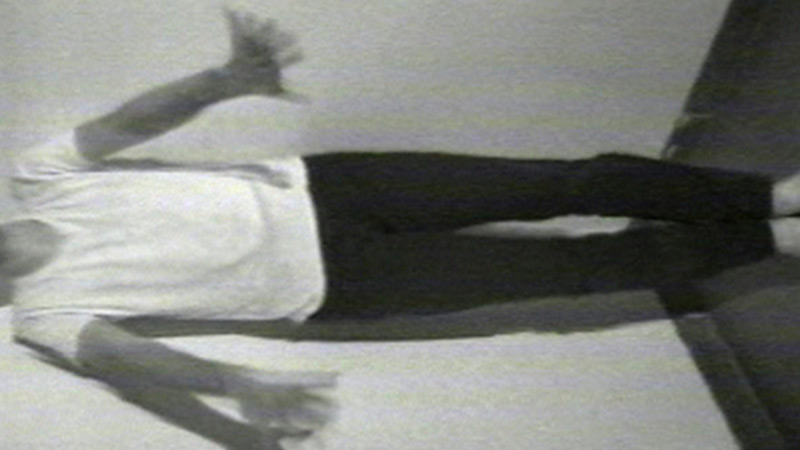
Bruce Nauman, Bouncing in the Corner No. 1, 1968 — Duration : 59mn41 — [Source]
— For this videotape, Nauman turned the camera sideways and positioned it so that his head is cropped from the frame and his body is presented from neck to ankles. As he stands in the corner, his back to the wall, he appears to be lying down; falling backwards into the corner and then pushing himself off the wall again, he appears to be trying to levitate himself... As he performs these actions, his hands slam into the wall to break his falls, and the sounds become an integral part of the activities filmed. — The EAI Archives Online
Bruce Nauman, Bouncing in the Corner No. 2 : Upside Down, 1969 — Duration : 60mn — [Source]
— The EAI Archives Online
Bruce Nauman, Wall floor positions, 1969 — Duration : 60mn — [Source]
— The EAI Archives Online
Bruce Nauman, Lip Sync, 1969 — Duration : 60mn49 — [Source]
— The EAI Archives Online
Bruce Nauman and Dan Graham have regularly compared the dimension of time in their early works with the musical output of composers like Steve Reich, whose “phasing” technique, based on the superposition of several identical lines of sound played at slightly differing speeds, foreshadows the use of a time delay in pieces like Bruce Nauman’s Lip Sync (1969).
Lip Sync, 1969, in which the camera is again upside down, focuses on Nauman’s mouth, chin, and throat as he repeats the words lip sync over and over, articulating them in a exaggerated manner. Nauman hears the words through the earphones that he wears, and then repeats them ; but the rhythm of the sound track on which he says the phrase is not synchronized with the movements of the lips on the screen — which are made even harder to comprehend because of their inversion. The lips and sound go in and out of sync. In contrast to the grainy, lyrical images of his films of 1967-68, which suggest a visual field on which one is free to impose one’s imagination, this video image separates what one hears from what one sees, forcing the viewer to try to match up sound and image. — (Coosje van Bruggen, Sounddance, In Bruce Nauman, Edited by Robert C. Morgan, Baltimore Mar. / London : The John Hopkins University Press, 2002, p. 60)
— — Des artistes comme Bruce Nauman et Dan Graham ont régulièrement rapproché la dimension temporelle de leurs premières œuvres de la production musicale de compositeurs tels que Steve Reich, dont la technique du phasing, basée sur la superposition de plusieurs lignes sonores identiques jouées à des vitesses légèrement différentes, préfigure l’utilisation d’un décalage temporel dans des pièces telles que Lip Sync (1969) de Bruce Nauman.
| NAUMAN & STEVE REICH […] Nauman compares his procedure of taking events in and out of synchronization to the composer Steve Reich’s use of a similar technique in Violin Phase, 1967, and It’s Gonna Rain, 1965. In the latter, several sound tracks are played a slightly different rate so that the phrase, « It’s gonna rain », repeated over and over, is altered at the points where the tracks don’t align. This not only causes the cadence to change but also breaks the sequence of the words, giving them a different meaning, somewhat in the manner of Nauman’s First Poem Piece, 1968, and Second Poem Piece, 1969. It interested Nauman, too, that Reich had picked up the phrase from a man voicing his opinion on New York’s Central Park. This was in accordance with his own practice of using the titles of popular songs, as in the drawing Love Me Tender, Move Te Lender, 1966, and in his neon piece Suite Substitute, 1968. In 1972 he took an exhortation, sprayed in red letters about 5 feet high on an overpass in Pasadena, California, for his yellow-and-pink neon piece Run from Fear, Run from Rear. Nauman met Reich in 1968 at the University of Colorado, where he was visiting William T. Wiley. Wiley and Reich were collaborating on a performance they entitled Overevident Falls, and Nauman became interested in Reich’s working methods while observing him as he recorded over the course of two days. Wiley recalls that Reich suspended a pair of microphones from a swing. Each time the wing passed in front of a set of amplifiers feedback was produced — a shriek, followed by a kind of howling sound when the swing reached the height of its motion before swinging back in the opposite direction. Meanwhile, Wiley poured soap flakes on the swing ; these fluoresced under a black light and softly drifted down to form a pile beneath the swing. Later that same year Reich used a similar device for his piece Pendulum Music, performed at the Whitney Museum of American Art. […] — (Coosje van Bruggen, Sounddance, In Bruce Nauman, Edited by Robert C. Morgan, Baltimore Mar. / London : The John Hopkins University Press, 2002, pp. 60-61) | 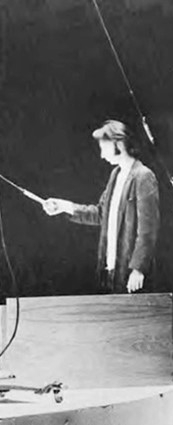 Bruce Nauman, playing Pendulum Music by Steve Reich, Whitney Museum of American Art, New York - May 27, 1969 |
(Click to enlarge)

Meredith Monk, Bruce Nauman, Richard Serra - Santa Barbara Arts Festival - 1970
Nauman and Serra placed subjects and matters in various constellations, with the aid of their own body, as well as different objects such as neon tubes or lead; performances in which they both participated also accentuated the process-oriented character of their constellating work. Especially the performance that they presented in 1970 together with Meredith Monk at the Santa Barbara Arts Festival demonstrates the relational, process-oriented way of dealing with their own body: Monk, completely in red, was moving for one hour across the stage, singing and talking. Nauman lay down on the edge of the stage, rolled towards the stage centre and back again, kept falling over the edge and climbing back on, and then started all over again. Eventually, Serra’s activities consisted in turning and lifting: occasionally, at his will, he would lift Monk and set her down again at another point of the stage. Thus, Monk, Nauman, and Serra functioned as those who structured the continually changing relations to one another, to the space, the architectural elements, and also the audience. — (Beatrice von Bismarck, Relations in Motion, In Curating Performing Arts, Frakcija #55, Performing Arts Journal, summer 2010, pp. 54-55)
Language & Chance operations(Edit)
| LANGUAGE « When language begins to break down a little bit, it becomes exciting and communicates in nearly the simplest way that it can function : you are forced to be aware of the sounds and the poetic parts of words. If you deal only with what is known, you’ll have redundancy; on the other hand, if you deal only with the unknown, you cannot communicate at all. There is always some combination of the two, and it is how they touch each other that makes communication interesting. » — (Bruce Nauman, 1989) Nauman has cited Wittgenstein as a major influence on his work and shares the philosopher’s concern with language and logic. Wittgenstein argues that without rules and shared attitudes towards the things around us, communication would be impossible. For example, in order for us to be able to discuss colour, there has to be an agreement or shared concept on what different colours are. Nauman presents us with what can happen if these understandings break down. « The limits of my language mean the limits of my world » – Ludwig Wittgenstein Nauman is also interested in the theories of Mikhail Bakhtin which are concerned with how human beings act and think and, particularly, how they communicate. His writings focus primarily on the concept of dialogue and the relationship between speaker and listener or respondent. He argues that all language and any form of speech or writing is dialogue, in other words, language is always the product of a speaker and a respondent. « Any speaker is himself a respondent to a greater or lesser degree. He is not, after all, the first speaker, the one who disturbs the eternal silence of the universe » — Mikhail Bahktin In Philosophical Investigations, Wittgenstein likens our use of language to a game, best described as a continuous play of meaning governed by various guidelines. While the definitive meaning of a statement resists determination, due to variation in private interpretations, this indefinite aspect finds its complement in the very real actions that result from communication. Investigation #77 suggests that in lacking definitive rules able to bridge the gap between private and public, our statements lack the ultimate truth we imagine them to have. Yet they are not without their function. The rules that govern language should be seen not as hard and fast laws, but as a variable set of guidelines. These are aimed at allowing communication to continue much in the way the rules of a game exist in order for play to continue. What we often fail to realize is that the rules need not be interpreted identically by the players, only that they continue to allow for further action and communication. Grounded in usefulness, Nauman’s artistic ethic can be described as “functional”; Wittgenstein’s philosophy of language will be referenced, both for its concern with the functional play between the private and public, subjective and objective dimensions of language, as well as for the philosopher’s influence on Nauman’s work. [Source] | CHANCE OPERATIONS Chance operations are one well-known application of a problem-solving approach to art-making. Nauman cites John Cage’s use of chance as influential, in particular as he used chance to integrate his artistic practice with his everyday life. Cage “opened” his compositions by incorporating everyday sounds, and the absence of sound, thus “transforming normal activity into a formal presentation” (Nauman, in Chris Dercon, “Keep Taking It Apart : A Conversation with Bruce Nauman” (July 12, 1986), Parkett 10, 1986). In a 1988 interview, in response to the comment that the phrase “a direct statement on how the artist lives, works, and thinks” could be applied to any number of Nauman works, he replies, “There was also the idea that if I was in the studio, whatever I was doing was art. Pacing around, for example” — (Bruce Nauman, in Joan Simon, “Breaking the Silence : An Interview with Bruce Nauman” (January, 1987), Art in America, n. 9, septembre 1988). It seems as though more of my life is concerned with things I care about that I can’t get into my work. It is important to me to be able to get these things into the work so that the art isn’t just something that I do off in the corner, while hiking in the mountains remains separate. — (in Joan Simon, “Breaking the Silence : An Interview with Bruce Nauman” (January, 1987), Art in America, n. 9, septembre 1988) Nauman explains, « [I]t comes from some thoughts about earlier work where you could control the length of the film or video tape or activity by having a specific job. You began when the job started, and when the job was over, the film was over. And that became a way of structuring it without having to think about it, other than deciding what the job was that you were going to call the work » (Bruce Nauman, in “Setting a Good Corner” par. 4, interview originally published on PBS.org in September 2001 and was republished on Art21.org in November 2011). The work acquires a sense of time as continuous and looping; the tape becomes something the viewer can walk away from and return to without “missing” a vital statement on the part of the artist. While Nauman, unlike Cage and the I-Ching, does not profess to a preferred method for incorporating indeterminateness, the decision to present the everyday as art, in combination with structuring of the work by way of the natural duration of its content allows for the incorporation of unexpected meanings. Even the most banal aspect of the task at hand – tool-care, for example – can acquire significance and invite interpretation. [Source] |
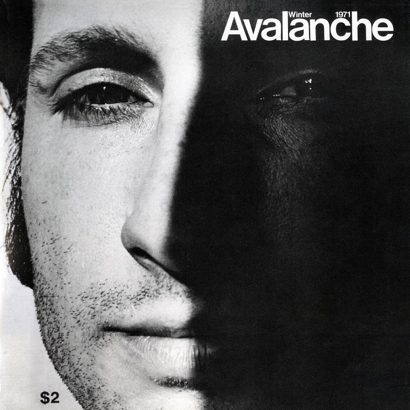   Bruce Nauman — Avalanche, no. 2 (Winter 1971) — Photos : Gianfranco Gorgoni. © Liza Béar and the Estate of Willoughby Sharp — [Source] |

